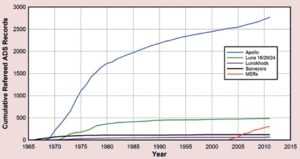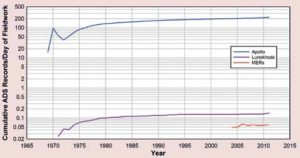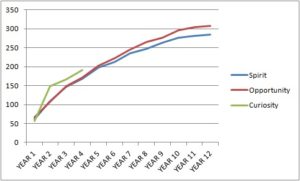Technology Narrative – November 14th
HUMAN EFFICIENCY ON MARS
Jon Clarke
Robotic missions of the surface of Mars have revealed much of the nature of the planet. Machines or extraordinary complexity has traversed more than 60 km of the surface. Add to this the achievements of robotic missions to the lunar surface and it is easy to see why many people have come to see this as both the norm and the ideal for planetary exploration.
Invaluable though these robotic missions have been to date, and no doubt will continue to be into the future, it is important not to lose sight of the fact that the most effective and efficient way to explore the surface of the Moon or Mars with by astronauts. In 2012 Dr. Ian Crawford of the University College London published an important comparison of the return from robotic and crewed exploration of the Moon and implications for Mars.
Cumulative number of publications for the Apollo, Luna 16/20/24, Lunokhod, Surveyor, and Mars Exploration Rover missions. From Crawford Figure 2 (2012).
The results of the Crawford paper are summarised by Figures 1 and 2. Figure 1 shows the cumulative number of papers published from Apollo compared with the important lunar and martian robotic missions. The graph shows not only have there been far more publications from Apollo by a factor of 10 to 100, Apollo missions continue to deliver new knowledge whereas publications from the robotic missions have levelled off.
Number of publications per exploration day exploring the surface of the Moon or Mars by astronauts and robotic rovers. From Crawford Figure 3 (2012).
This productivity is even more remarkable when we consider that the Apollo crews spent only 3.4 days on the Moon, whereas robotic missions operated for weeks to months. Dividing the number of papers for the Apollo and lunar robotic rover missions gives scientific productivity per day, and is shown in Figure 2. Apollo missions were between 100 and 1000 times as productive as robotic rovers on this criterion.
Cumulative number of publications for the Apollo Mars Exploration Rover missions and Curiosity rover mission in years.
In Figure 3 I have updated the publication data for the Mars Exploration rovers to January 2016. This figure also shows that cumulative publications for the Mars Exploration rover mission have also begun to level off, even before the end of the mission. Although the Curiosity mission has only been on Mars for a total of four years, it too is following the same trend. The productivity per day of the Mars Exploration rover missions is about one hundredth of that for Apollo over a comparable period (Figure 4).
Number of publications per exploration day for the Mars Exploration Rover and Curiosity rover missions.
From these data I conclude that, while robotic exploration has been, and will be valuable into the future, the real exploration of Mars will only begin once astronauts are working on the surface. Compared to Apollo astronauts, those on Mars will have far better tools and support and will be able to work even more effectively.
The full paper by Dr Ian Crawford can be read online in the journal Astronomy and Geophysics http://astrogeo.oxfordjournals.org/content/53/2/2.22.full.pdf+html







